After checking compression, what's the next step to do??
Depends on whether you've discovered a problem. If the compression test comes back with all cylinders in good order, you might not be looking at a head/piston problem, it might be fuel (or injector) related - depends on what you observe.
IF the compression produced by each cylinder is between 363psi and 450psi AND there's no more than 71psi difference between any two cylinders, THEN your head, pistons and rings are likely to be in good order (see below). If not, then a WET compression test needs to be done (add a little oil to each cylinder and run the test again).
IF the compression improves to "normal" (as per prev paragraph) after adding oil, there's bore damage or piston ring wear (or siezed).
IF the compression between two cylinders starts to drop after adding oil, it's more likely that the head gasket is damaged.
If the compression test is successful, the next thing to check is whether or not any fuel is reaching the injectors. After a small period of cranking, you should be able to smell diesel fuel in the exhaust. If not, try priming the system - you should not be able to easily squeeze the primer bulb more than 3-4 times (it should get quite firm). If it takes more than 5-6 squeezes to get it firm it's possible that there's a leak allowing air into the line which then causes the fuel to flow back to the tank. If THIS happens, overprime the system (keep pumping) until diesel starts to leak - that's where you have to fix the system.
If the car actually coughs now and again but won't start properly, block the EGR off (replace the gasket on the intake manifold side with a piece of 1mm stainless (or 2mm mild steel or 3mm aluminium).

























